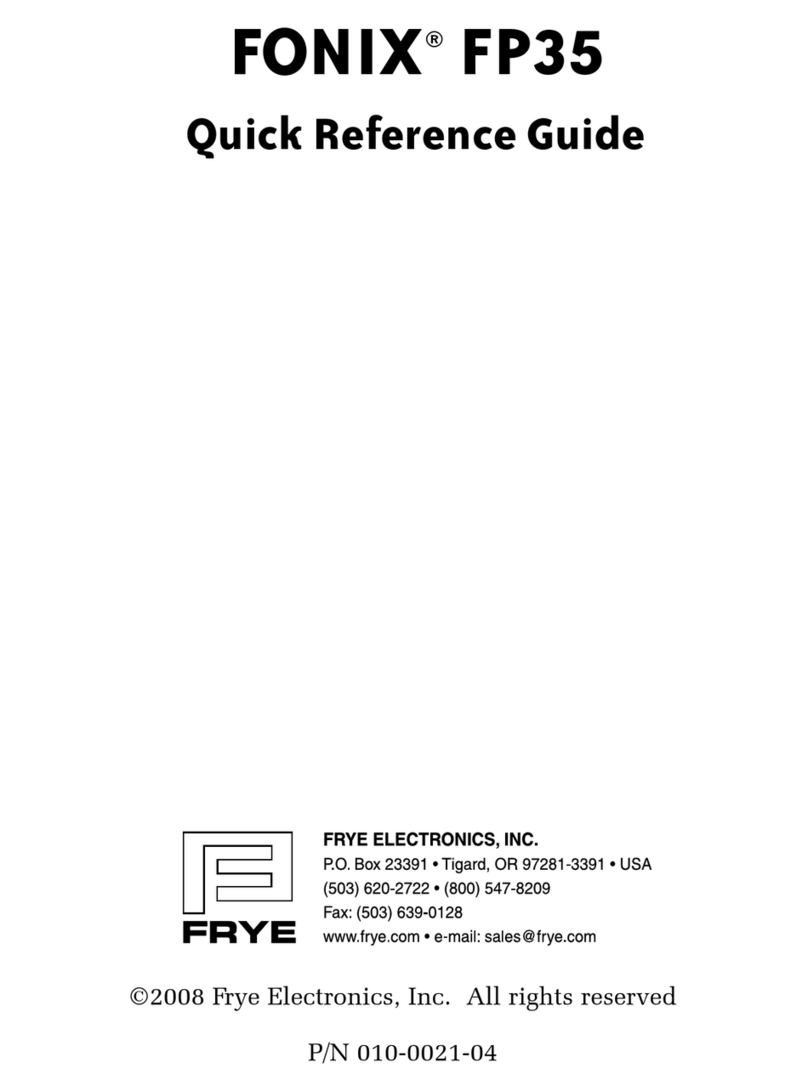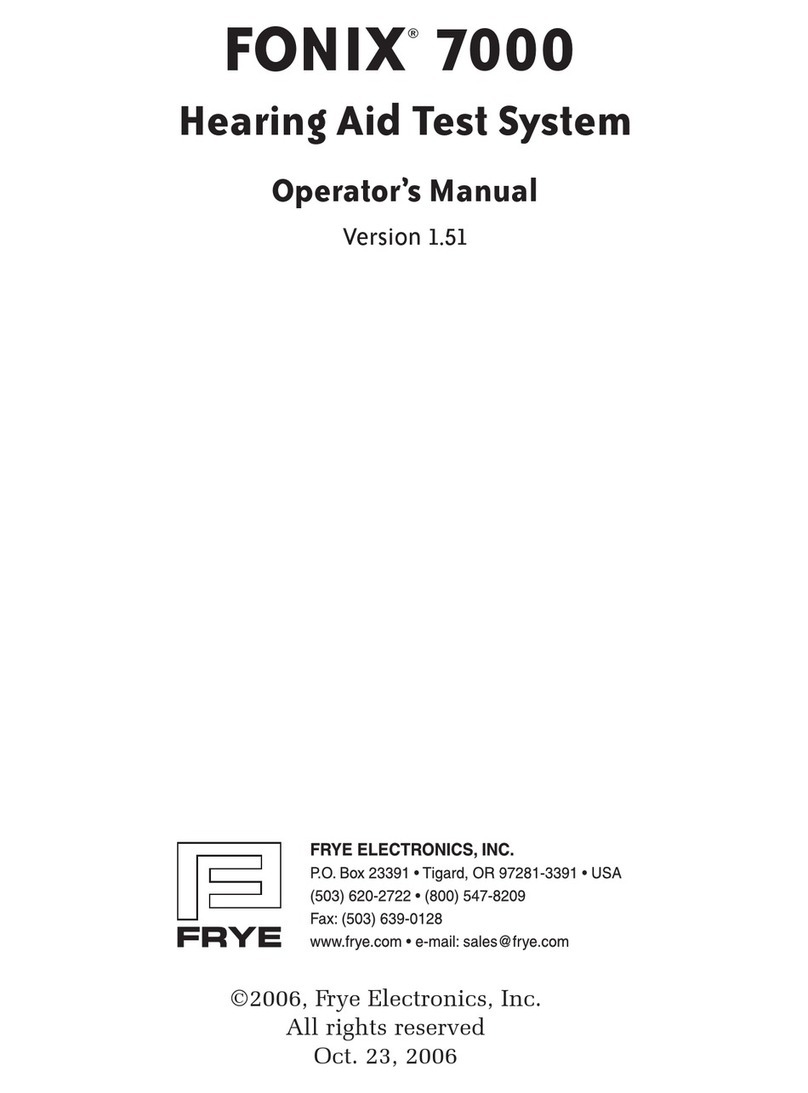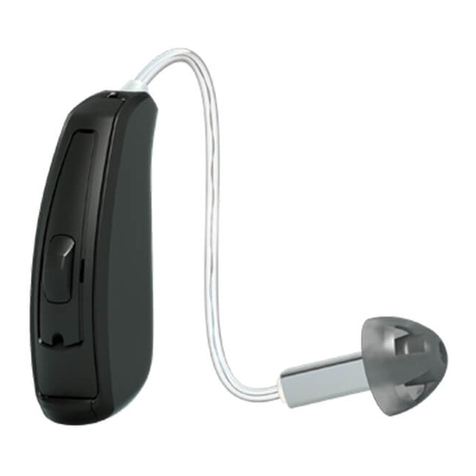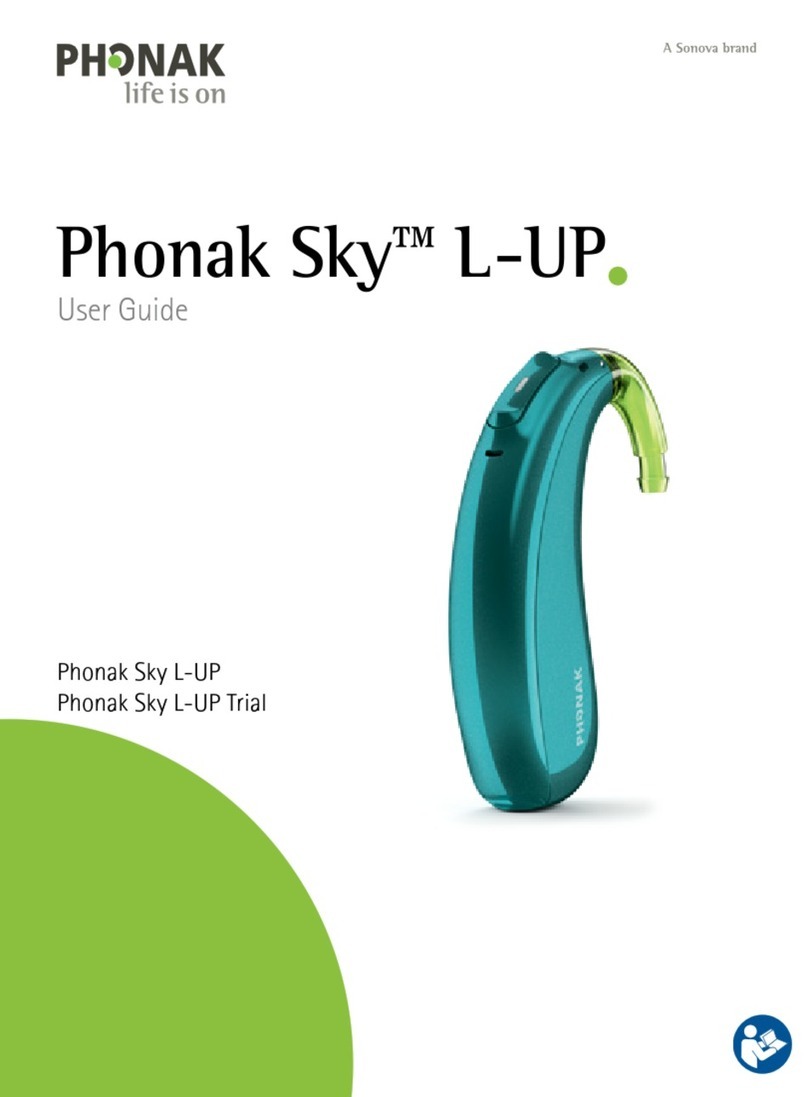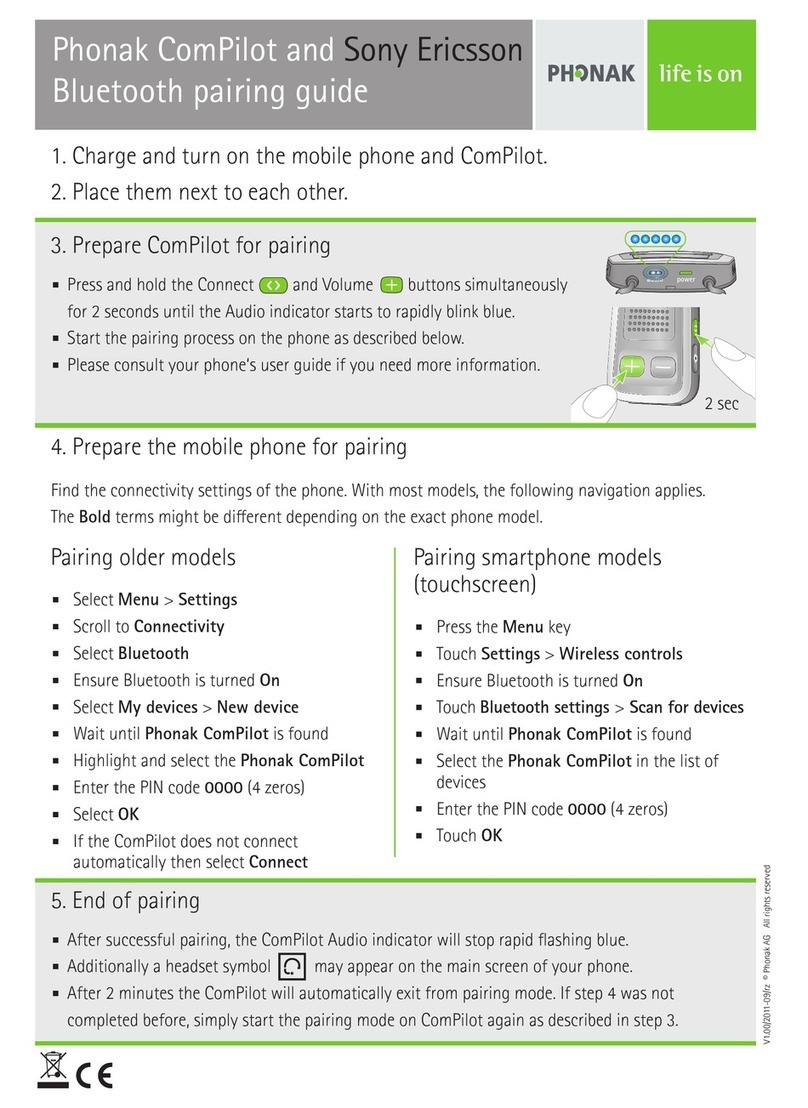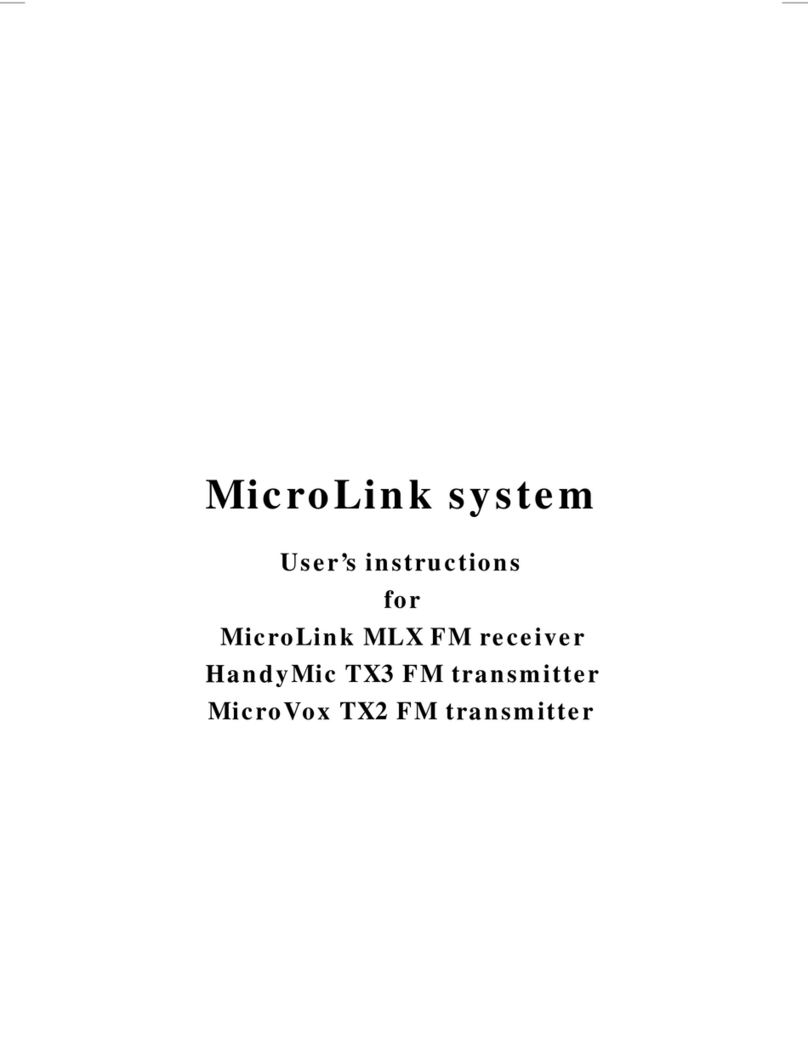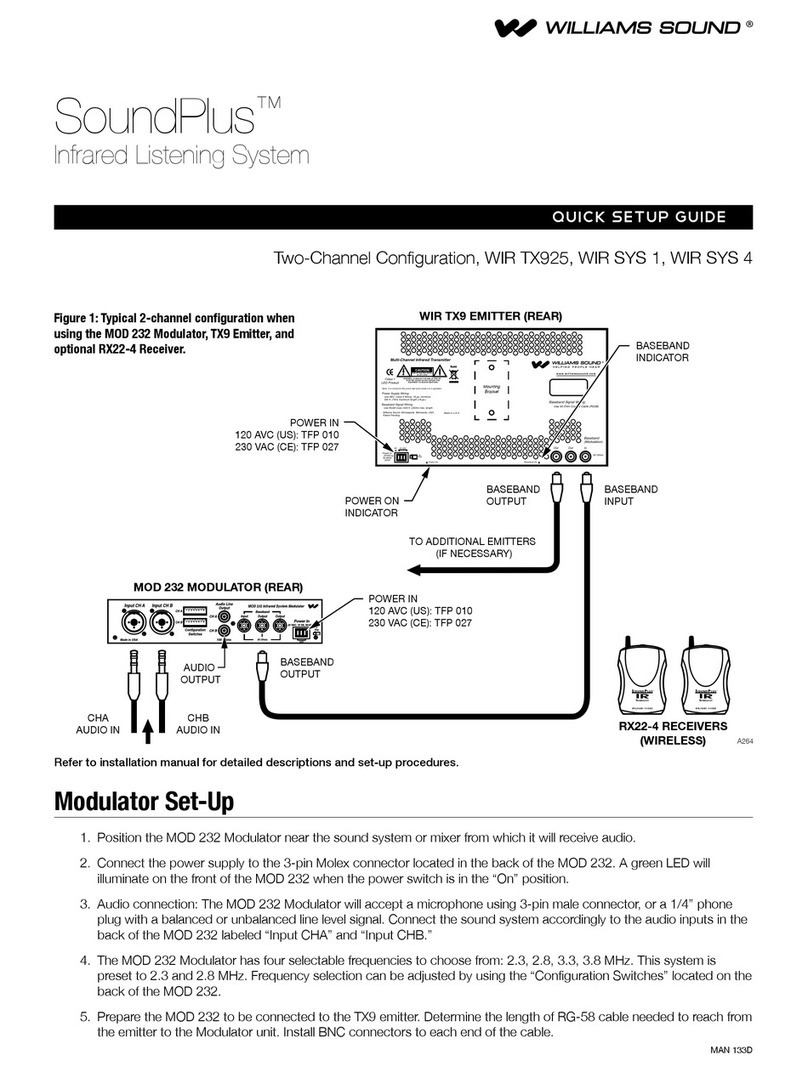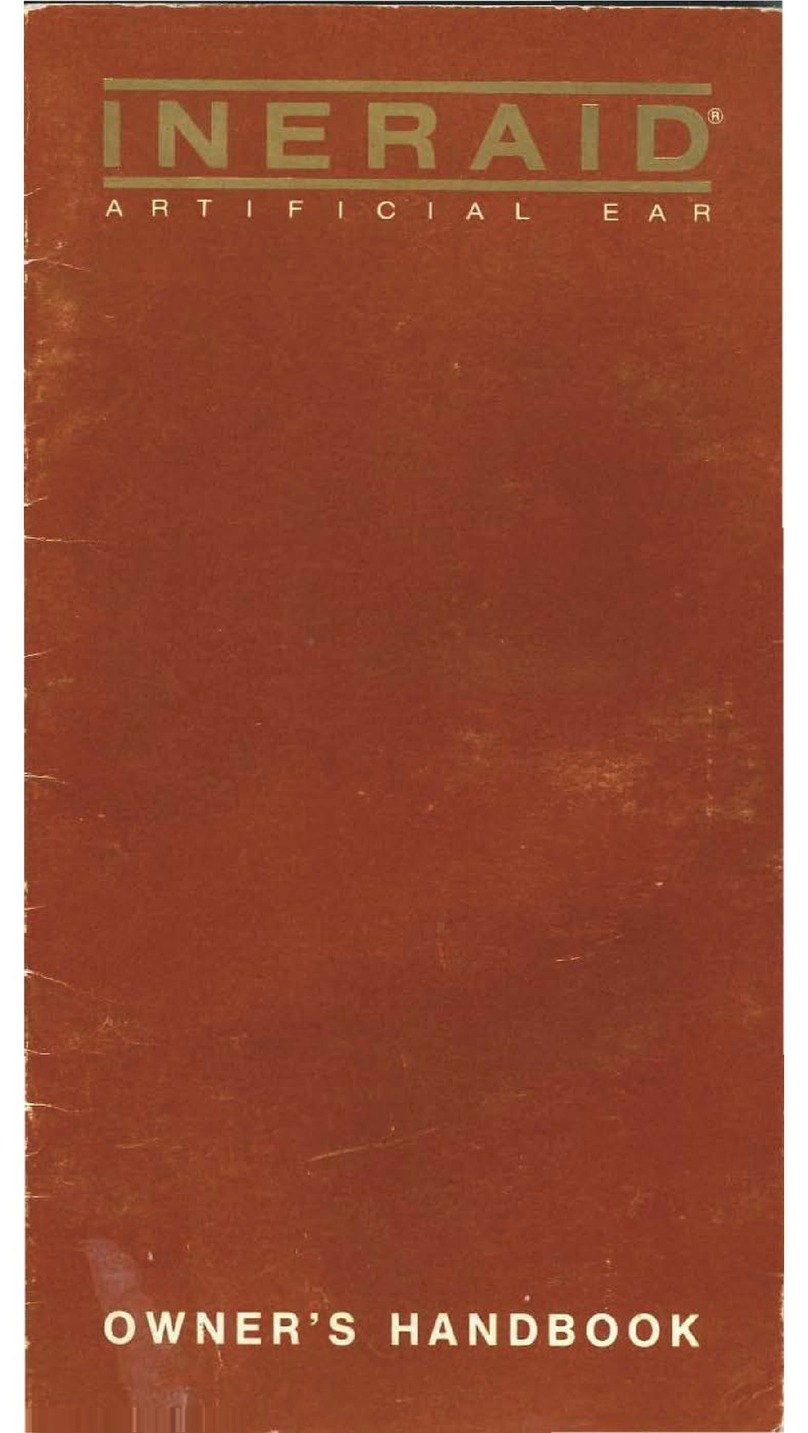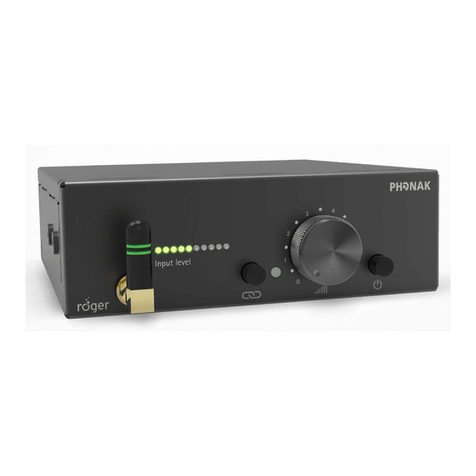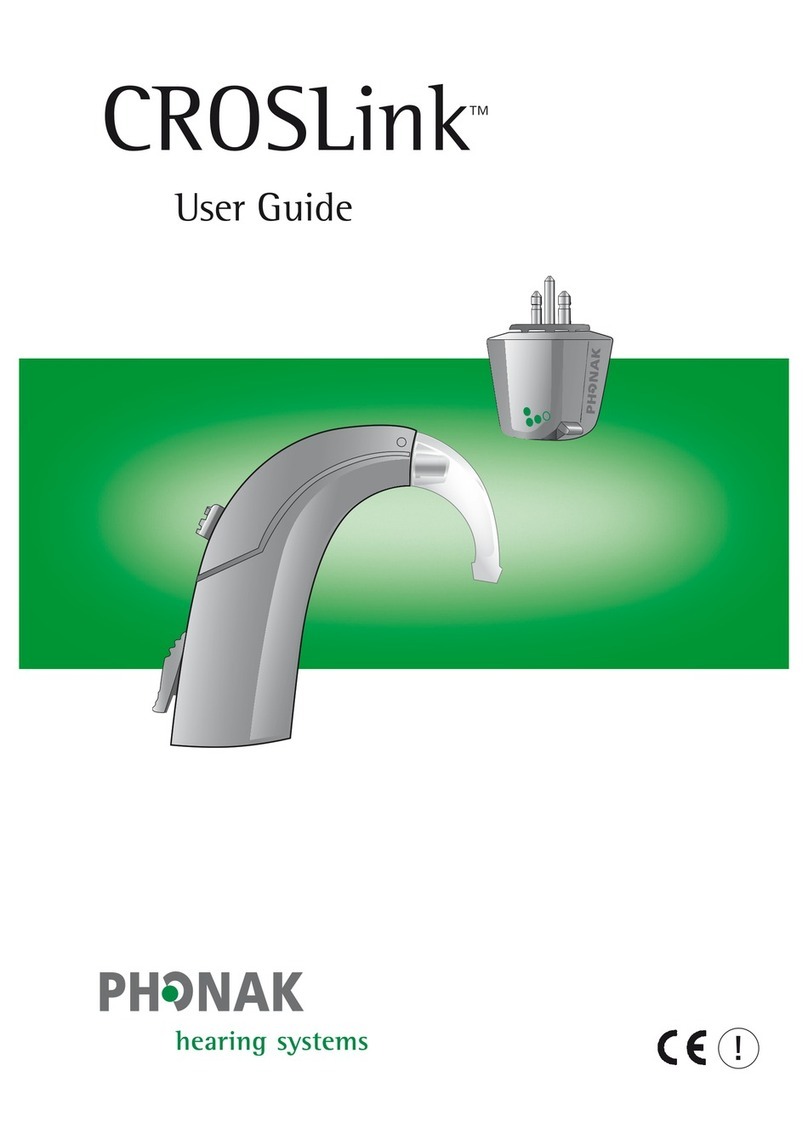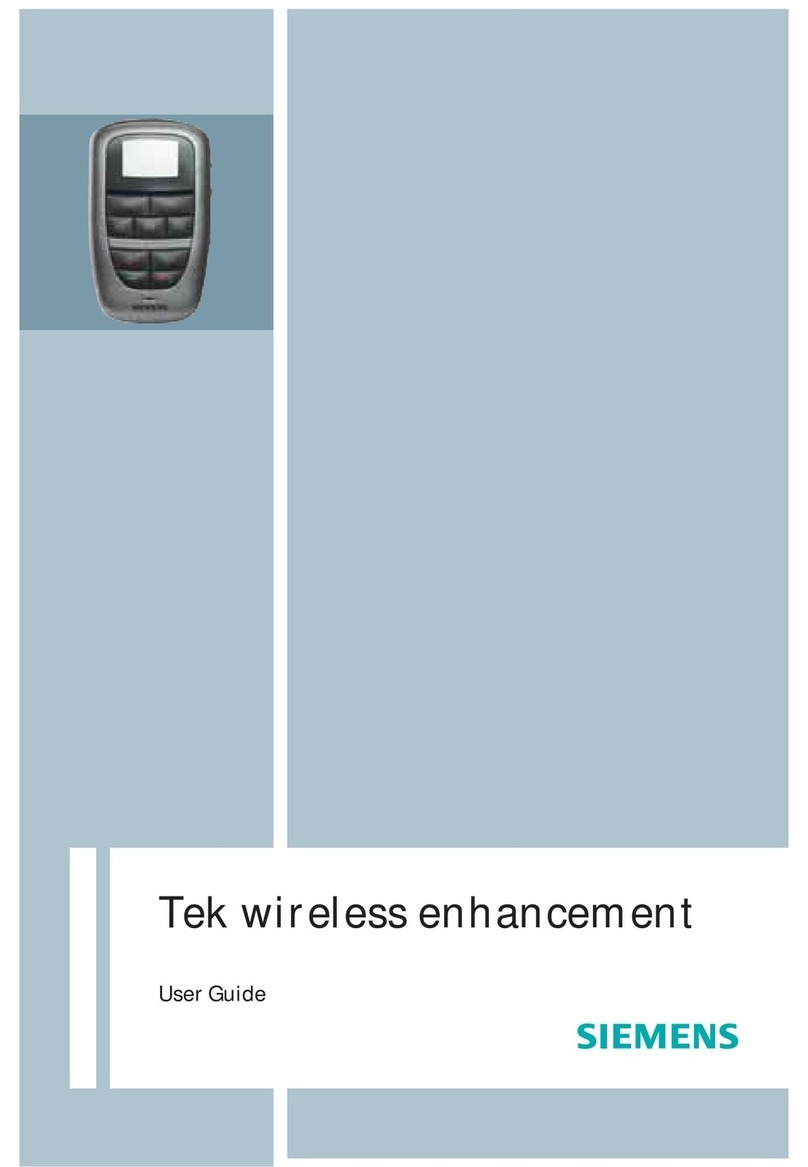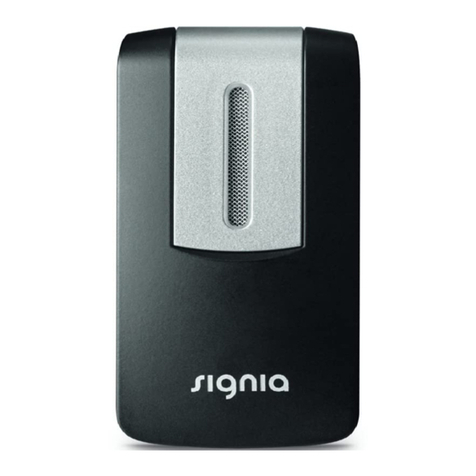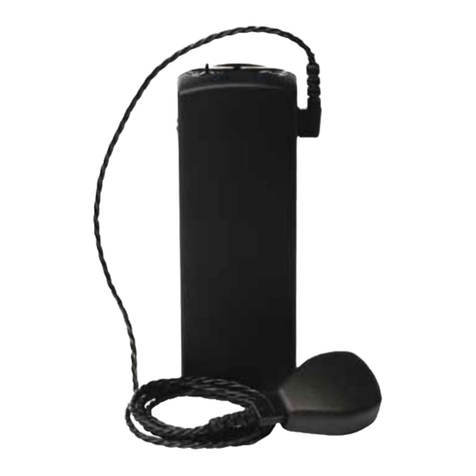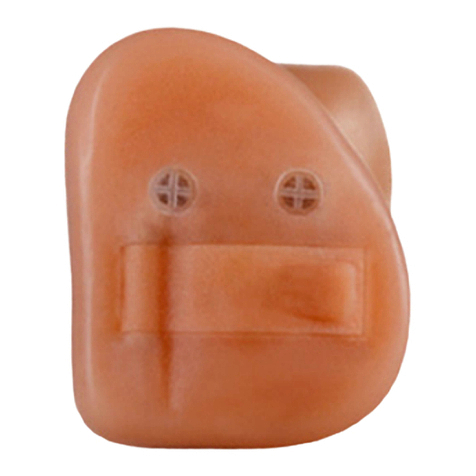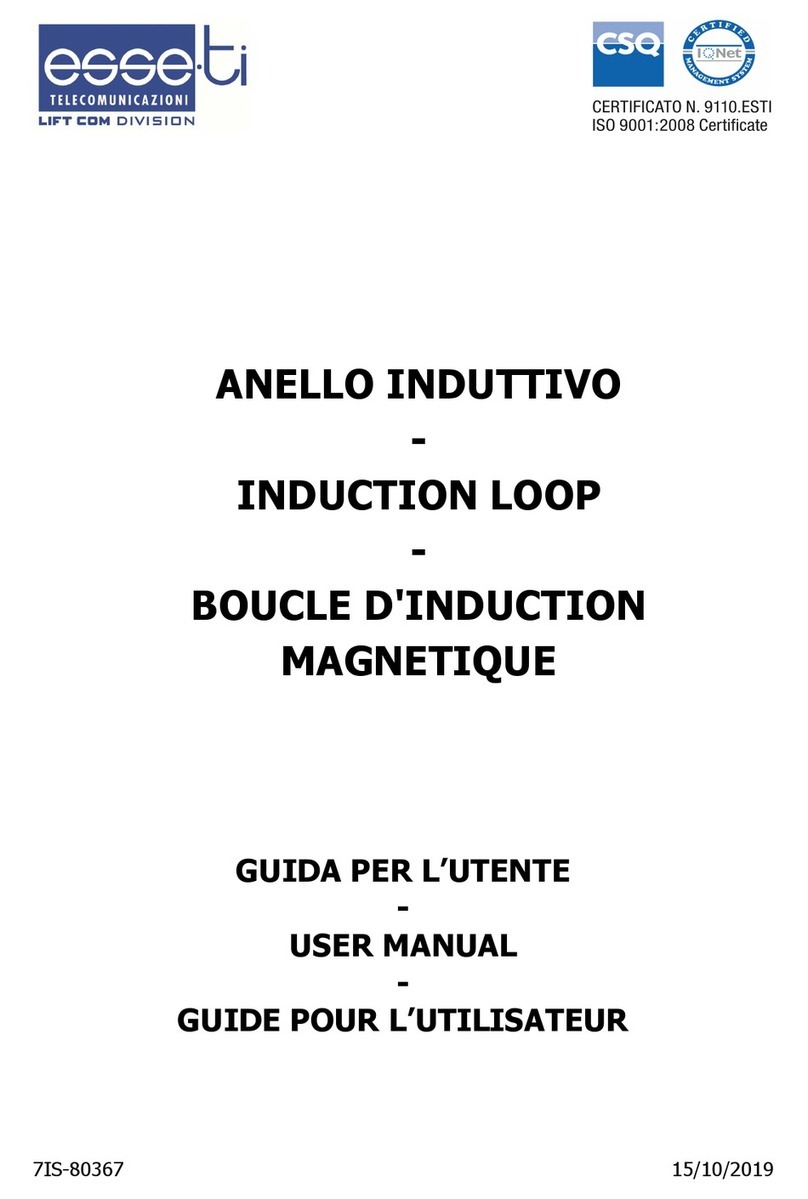Frye FONIX FP40 User manual

FONIX® FP40/FP40D
PORTABLE HEARING AID ANALYZER
OPERATOR’S MANUAL
Software Version 3.70 © September 2005 Frye Electronics, Inc.
Rev. Jun. 04, 2007 All Rights Reserved.
A Note on this Manual
The instructions in this manual are for software version
3.70 and above, with references to earlier software.
However, you may contact Frye Electronics for a more
appropriate manual if you have earlier software.


Table of Contents
Chapter 1: Introduction
1.1 Description . . . . . . . . . . . . . . . . . . . . . . . . . . . . . . . . . . . . . . . . . . . . . . . . . . . . . . . . 1
1.2 Hardware History . . . . . . . . . . . . . . . . . . . . . . . . . . . . . . . . . . . . . . . . . . . . . . . . . . . 1
1.3 Features & Options . . . . . . . . . . . . . . . . . . . . . . . . . . . . . . . . . . . . . . . . . . . . . . . . . . 2
1.3.1 Composite/Digital Speech Option . . . . . . . . . . . . . . . . . . . . . . . . . . . . . . . . . 2
1.3.2 Probe Option. . . . . . . . . . . . . . . . . . . . . . . . . . . . . . . . . . . . . . . . . . . . . . . . . . 3
1.3.3 External Video Monitor. . . . . . . . . . . . . . . . . . . . . . . . . . . . . . . . . . . . . . . . . . 3
1.3.4 Battery Pack Option . . . . . . . . . . . . . . . . . . . . . . . . . . . . . . . . . . . . . . . . . . . . 3
1.3.5 ID Option . . . . . . . . . . . . . . . . . . . . . . . . . . . . . . . . . . . . . . . . . . . . . . . . . . . . 4
1.3.6 RS232 Option . . . . . . . . . . . . . . . . . . . . . . . . . . . . . . . . . . . . . . . . . . . . . . . . . 4
1.3.7 OES (Occluded Ear Simulator) Option . . . . . . . . . . . . . . . . . . . . . . . . . . . . . . 4
1.3.8 CIC (Completely In the Canal) Option. . . . . . . . . . . . . . . . . . . . . . . . . . . . . . . 4
1.4 Accessories. . . . . . . . . . . . . . . . . . . . . . . . . . . . . . . . . . . . . . . . . . . . . . . . . . . . . . . . . 5
1.4.1 Standard Accessories . . . . . . . . . . . . . . . . . . . . . . . . . . . . . . . . . . . . . . . . . . . 5
1.4.2 Optional Accessories . . . . . . . . . . . . . . . . . . . . . . . . . . . . . . . . . . . . . . . . . . . . 6
1.4.3 Real-Ear Accessories . . . . . . . . . . . . . . . . . . . . . . . . . . . . . . . . . . . . . . . . . . . . 8
1.5 Layout & Controls . . . . . . . . . . . . . . . . . . . . . . . . . . . . . . . . . . . . . . . . . . . . . . . . . . 10
1.5.1 LCD (Liquid Crystal Display) . . . . . . . . . . . . . . . . . . . . . . . . . . . . . . . . . . . . 10
1.5.2 Front Panel Buttons . . . . . . . . . . . . . . . . . . . . . . . . . . . . . . . . . . . . . . . . . . . 11
1.5.3 Front Panel Lamps . . . . . . . . . . . . . . . . . . . . . . . . . . . . . . . . . . . . . . . . . . . . 11
1.5.4 Front Panel Knobs . . . . . . . . . . . . . . . . . . . . . . . . . . . . . . . . . . . . . . . . . . . . 12
1.5.5 Rear Panel Controls . . . . . . . . . . . . . . . . . . . . . . . . . . . . . . . . . . . . . . . . . . . 12
1.5.6 Right Side Mounted Jack and Module . . . . . . . . . . . . . . . . . . . . . . . . . . . . . 13
1.5.7 Sound Chamber Mounted Jacks and Controls . . . . . . . . . . . . . . . . . . . . . . . 13
1.5.8 Top of Instrument, Printer . . . . . . . . . . . . . . . . . . . . . . . . . . . . . . . . . . . . . . 13
1.6 FP40 Setup . . . . . . . . . . . . . . . . . . . . . . . . . . . . . . . . . . . . . . . . . . . . . . . . . . . . . . . 14
1.6.1 Setting up the instrument. . . . . . . . . . . . . . . . . . . . . . . . . . . . . . . . . . . . . . . 14
1.6.2 Connecting equipment . . . . . . . . . . . . . . . . . . . . . . . . . . . . . . . . . . . . . . . . . 14
1.6.3 Connecting the line cord. . . . . . . . . . . . . . . . . . . . . . . . . . . . . . . . . . . . . . . . 15
1.7 Miscellaneous . . . . . . . . . . . . . . . . . . . . . . . . . . . . . . . . . . . . . . . . . . . . . . . . . . . . . 15
1.7.1 Servicing Your FP40 . . . . . . . . . . . . . . . . . . . . . . . . . . . . . . . . . . . . . . . . . . . 15
1.7.2 Cleaning the FP40 Display . . . . . . . . . . . . . . . . . . . . . . . . . . . . . . . . . . . . . . 15
1.7.3 Emergency Shutdown . . . . . . . . . . . . . . . . . . . . . . . . . . . . . . . . . . . . . . . . . . 16
1.7.4 Warranty. . . . . . . . . . . . . . . . . . . . . . . . . . . . . . . . . . . . . . . . . . . . . . . . . . . . 16
Chapter 2: General Operation
2.1 Screen Navigation . . . . . . . . . . . . . . . . . . . . . . . . . . . . . . . . . . . . . . . . . . . . . . . . . . 17
2.2 General Setup Menu . . . . . . . . . . . . . . . . . . . . . . . . . . . . . . . . . . . . . . . . . . . . . . . . 17
2.2.1 Making selections . . . . . . . . . . . . . . . . . . . . . . . . . . . . . . . . . . . . . . . . . . . . 18
2.2.2 Saving changes . . . . . . . . . . . . . . . . . . . . . . . . . . . . . . . . . . . . . . . . . . . . . . . 18
2.2.3 Switching between partial and full menus . . . . . . . . . . . . . . . . . . . . . . . . . . 18
2.3 Using Function Keys . . . . . . . . . . . . . . . . . . . . . . . . . . . . . . . . . . . . . . . . . . . . . . . . 19
2.3.1 Hints . . . . . . . . . . . . . . . . . . . . . . . . . . . . . . . . . . . . . . . . . . . . . . . . . . . . . . . 19

2.3.2 Customizing the function keys . . . . . . . . . . . . . . . . . . . . . . . . . . . . . . . . . . . 20
2.4 Source Types . . . . . . . . . . . . . . . . . . . . . . . . . . . . . . . . . . . . . . . . . . . . . . . . . . . . . . 21
2.4.1 Understanding Pure-tone signals . . . . . . . . . . . . . . . . . . . . . . . . . . . . . . . . . 21
2.4.1.1 Pure-tone settings . . . . . . . . . . . . . . . . . . . . . . . . . . . . . . . . . . . . . 22
2.4.1.2 Noise Reduction. . . . . . . . . . . . . . . . . . . . . . . . . . . . . . . . . . . . . . . . . . . . . 22
2.4.1.3 Settling Time . . . . . . . . . . . . . . . . . . . . . . . . . . . . . . . . . . . . . . . . . 22
2.4.1.4 Harmonic Distortion . . . . . . . . . . . . . . . . . . . . . . . . . . . . . . . . . . . 23
2.4.2 Understanding Composite signals. . . . . . . . . . . . . . . . . . . . . . . . . . . . . . . . . 23
2.4.2.1 ICRA vs. ANSI . . . . . . . . . . . . . . . . . . . . . . . . . . . . . . . . . . . . . . . . . . . . . . 23
2.4.2.2 Noise Reduction. . . . . . . . . . . . . . . . . . . . . . . . . . . . . . . . . . . . . . . . . . . . . 24
2.4.2.3 Intermodulation Distortion . . . . . . . . . . . . . . . . . . . . . . . . . . . . . . . . . . . . 24
2.4.2.4 Composite source levels. . . . . . . . . . . . . . . . . . . . . . . . . . . . . . . . . . . . . . . 25
2.5 Display Mode. . . . . . . . . . . . . . . . . . . . . . . . . . . . . . . . . . . . . . . . . . . . . . . . . . . . . . 26
2.6 Battery Current Drain . . . . . . . . . . . . . . . . . . . . . . . . . . . . . . . . . . . . . . . . . . . . . . . 26
2.7 Using the DATA button . . . . . . . . . . . . . . . . . . . . . . . . . . . . . . . . . . . . . . . . . . . . . . 28
2.8 External Sound Chamber or Speaker. . . . . . . . . . . . . . . . . . . . . . . . . . . . . . . . . . . . 28
2.9 Printing . . . . . . . . . . . . . . . . . . . . . . . . . . . . . . . . . . . . . . . . . . . . . . . . . . . . . . . . . . 29
2.9.1 Selecting the printer . . . . . . . . . . . . . . . . . . . . . . . . . . . . . . . . . . . . . . . . . . . 29
2.9.2 Using the thermal printer . . . . . . . . . . . . . . . . . . . . . . . . . . . . . . . . . . . . . . . 29
2.9.3 Using an external printer . . . . . . . . . . . . . . . . . . . . . . . . . . . . . . . . . . . . . . . 30
2.9.4 Printing a label . . . . . . . . . . . . . . . . . . . . . . . . . . . . . . . . . . . . . . . . . . . . . . . 31
2.10 The Opening Screen . . . . . . . . . . . . . . . . . . . . . . . . . . . . . . . . . . . . . . . . . . . . . . . 32
2.11 The Battery Option (not available on FP40-D) . . . . . . . . . . . . . . . . . . . . . . . 32
Chapter 3: Coupler Measurements
3.1 The Main Coupler Screen . . . . . . . . . . . . . . . . . . . . . . . . . . . . . . . . . . . . . . . . . . . . 35
3.1.1 Viewing a Pure-tone display . . . . . . . . . . . . . . . . . . . . . . . . . . . . . . . . . . . . . 35
3.1.2 Viewing a Composite display . . . . . . . . . . . . . . . . . . . . . . . . . . . . . . . . . . . . 36
3.2 Leveling . . . . . . . . . . . . . . . . . . . . . . . . . . . . . . . . . . . . . . . . . . . . . . . . . . . . . . . . . 36
3.2.1 Leveling without the reference microphone (standard) . . . . . . . . . . . . . . . . 37
3.2.2 Leveling with the reference microphone. . . . . . . . . . . . . . . . . . . . . . . . . . . . 37
3.2.3 Saving the leveling information . . . . . . . . . . . . . . . . . . . . . . . . . . . . . . . . . . 38
3.3 Hearing Aid Setup . . . . . . . . . . . . . . . . . . . . . . . . . . . . . . . . . . . . . . . . . . . . . . . . . . 38
3.3.1 Setting up a BTE. . . . . . . . . . . . . . . . . . . . . . . . . . . . . . . . . . . . . . . . . . . . . . 39
3.3.2 Setting up an ITE/ITC/CIC . . . . . . . . . . . . . . . . . . . . . . . . . . . . . . . . . . . . . . 39
3.3.3 Setting up a body aid . . . . . . . . . . . . . . . . . . . . . . . . . . . . . . . . . . . . . . . . . . 41
3.3.4 Setting up an eyeglass aid . . . . . . . . . . . . . . . . . . . . . . . . . . . . . . . . . . . . . . 41
3.4 Frequency responses . . . . . . . . . . . . . . . . . . . . . . . . . . . . . . . . . . . . . . . . . . . . . . . . 42
3.4.1 Choosing a source type. . . . . . . . . . . . . . . . . . . . . . . . . . . . . . . . . . . . . . . . . 42
3.4.2 Taking the measurement. . . . . . . . . . . . . . . . . . . . . . . . . . . . . . . . . . . . . . . . 43
3.4.3 Viewing multiple measurements. . . . . . . . . . . . . . . . . . . . . . . . . . . . . . . . . . 44
3.4.4 Taking a single frequency response . . . . . . . . . . . . . . . . . . . . . . . . . . . . . . . . 44
3.4.5 Taking a three frequency average . . . . . . . . . . . . . . . . . . . . . . . . . . . . . . . . . 45

3.4.6 Viewing harmonic distortion. . . . . . . . . . . . . . . . . . . . . . . . . . . . . . . . . . . . . 45
3.4.7 Viewing battery current drain. . . . . . . . . . . . . . . . . . . . . . . . . . . . . . . . . . . . 46
3.4.8 Switching between gain and output . . . . . . . . . . . . . . . . . . . . . . . . . . . . . . . 46
3.4.9 Testing with the reference microphone. . . . . . . . . . . . . . . . . . . . . . . . . . . . . 46
3.5 Digital Aids . . . . . . . . . . . . . . . . . . . . . . . . . . . . . . . . . . . . . . . . . . . . . . . . . . . . . . . . 47
3.5.1 Testing with Digital Speech . . . . . . . . . . . . . . . . . . . . . . . . . . . . . . . . . . . . . 48
3.5.2 Testing with the Composite Signal . . . . . . . . . . . . . . . . . . . . . . . . . . . . . . . . 48
3.5.3 Testing with pure-tone sweeps . . . . . . . . . . . . . . . . . . . . . . . . . . . . . . . . . . . 49
3.6 Directional Hearing Aids . . . . . . . . . . . . . . . . . . . . . . . . . . . . . . . . . . . . . . . . . . . . . 49
3.6.1 Preparing for the measurement . . . . . . . . . . . . . . . . . . . . . . . . . . . . . . . . . . 50
3.6.2 Taking the Forward Measurement . . . . . . . . . . . . . . . . . . . . . . . . . . . . . . . . . 50
3.6.3. Taking the Reverse Measurement . . . . . . . . . . . . . . . . . . . . . . . . . . . . . . . . . 51
3.7 The CIC Option . . . . . . . . . . . . . . . . . . . . . . . . . . . . . . . . . . . . . . . . . . . . . . . . . . . . 52
3.8 The OES Option. . . . . . . . . . . . . . . . . . . . . . . . . . . . . . . . . . . . . . . . . . . . . . . . . . . . 53
Chapter 4: Automated Test Sequences
4.1 ANSI S3.22-2003 . . . . . . . . . . . . . . . . . . . . . . . . . . . . . . . . . . . . . . . . . . . . . . . . . . . 55
4.1.1 Setting up the aid for testing . . . . . . . . . . . . . . . . . . . . . . . . . . . . . . . . . . . . 56
4.1.2 Setting up the analyzer for testing . . . . . . . . . . . . . . . . . . . . . . . . . . . . . . . . 56
4.1.3 Running the test sequence . . . . . . . . . . . . . . . . . . . . . . . . . . . . . . . . . . . . . . 58
4.1.4 Viewing the results . . . . . . . . . . . . . . . . . . . . . . . . . . . . . . . . . . . . . . . . . . . . 58
4.2 ANSI S3.22-1996 . . . . . . . . . . . . . . . . . . . . . . . . . . . . . . . . . . . . . . . . . . . . . . . . . . . 59
4.2.1 Setting up the aid for testing . . . . . . . . . . . . . . . . . . . . . . . . . . . . . . . . . . . . 59
4.2.2 Setting up the analyzer for testing . . . . . . . . . . . . . . . . . . . . . . . . . . . . . . . . 60
4.2.3 Running the test sequence . . . . . . . . . . . . . . . . . . . . . . . . . . . . . . . . . . . . . . 61
4.2.4 Viewing the results . . . . . . . . . . . . . . . . . . . . . . . . . . . . . . . . . . . . . . . . . . . . 62
4.3 ANSI S3.22-1987 . . . . . . . . . . . . . . . . . . . . . . . . . . . . . . . . . . . . . . . . . . . . . . . . . . . 63
4.3.1 Setting up for the test. . . . . . . . . . . . . . . . . . . . . . . . . . . . . . . . . . . . . . . . . . 63
4.3.2 Running the test sequence . . . . . . . . . . . . . . . . . . . . . . . . . . . . . . . . . . . . . . 64
4.3.3 Viewing the results . . . . . . . . . . . . . . . . . . . . . . . . . . . . . . . . . . . . . . . . . . . . 64
4.4 ANSI S3.42-1992 . . . . . . . . . . . . . . . . . . . . . . . . . . . . . . . . . . . . . . . . . . . . . . . . . . . 65
4.4.1 Setting up for the test. . . . . . . . . . . . . . . . . . . . . . . . . . . . . . . . . . . . . . . . . . 66
4.4.2 Running the test sequence . . . . . . . . . . . . . . . . . . . . . . . . . . . . . . . . . . . . . . 66
4.4.3 Viewing the results . . . . . . . . . . . . . . . . . . . . . . . . . . . . . . . . . . . . . . . . . . . . 67
4.5 IEC. . . . . . . . . . . . . . . . . . . . . . . . . . . . . . . . . . . . . . . . . . . . . . . . . . . . . . . . . . . . . . 67
4.5.1 Setting up the aid for testing . . . . . . . . . . . . . . . . . . . . . . . . . . . . . . . . . . . . 67
4.5.2 Setting up the analyzer for testing. . . . . . . . . . . . . . . . . . . . . . . . . . . . . . . . . . . . . . . 68
4.5.3 Running the test sequence . . . . . . . . . . . . . . . . . . . . . . . . . . . . . . . . . . . . . . 69
4.5.4 Viewing the results . . . . . . . . . . . . . . . . . . . . . . . . . . . . . . . . . . . . . . . . . . . . 69
4.6 Profiler. . . . . . . . . . . . . . . . . . . . . . . . . . . . . . . . . . . . . . . . . . . . . . . . . . . . . . . . . . . 70
4.6.1 Setting up for the test. . . . . . . . . . . . . . . . . . . . . . . . . . . . . . . . . . . . . . . . . . 70
4.6.2 Running the test sequence . . . . . . . . . . . . . . . . . . . . . . . . . . . . . . . . . . . . . . 71
4.6.3 Viewing the results . . . . . . . . . . . . . . . . . . . . . . . . . . . . . . . . . . . . . . . . . . . . 71
4.7 ACIC . . . . . . . . . . . . . . . . . . . . . . . . . . . . . . . . . . . . . . . . . . . . . . . . . . . . . . . . . . . . 72

Chapter 5: Real-Ear Measurements
5.1 Preparation for Real-Ear Measurements . . . . . . . . . . . . . . . . . . . . . . . . . . . . . . . . . 73
5.1.1 Setting up the analyzer for testing . . . . . . . . . . . . . . . . . . . . . . . . . . . . . . . . 73
5.1.1.1 To set up the microphones and monitor headset . . . . . . . . . . . . . . . . . . . . 73
5.1.1.2 To set up the internal sound field speaker. . . . . . . . . . . . . . . . . . . . . . . . . 74
5.1.1.3 To set up an external sound field speaker . . . . . . . . . . . . . . . . . . . . . . . . . 76
5.1.2 Setting up the client for testing . . . . . . . . . . . . . . . . . . . . . . . . . . . . . . . . . . 76
5.1.2.1 To position the sound field speaker . . . . . . . . . . . . . . . . . . . . . . . . . . . . . . 76
5.1.2.2 To place the earhook and reference microphone. . . . . . . . . . . . . . . . . . . . 77
5.1.2.3 To insert the probe tube. . . . . . . . . . . . . . . . . . . . . . . . . . . . . . . . . 78
5.1.2.4 To level the sound field . . . . . . . . . . . . . . . . . . . . . . . . . . . . . . . . . . . . . . . 79
5.2 The Target Screen . . . . . . . . . . . . . . . . . . . . . . . . . . . . . . . . . . . . . . . . . . . . . . . . . . 80
5.2.1 Viewing the target screen . . . . . . . . . . . . . . . . . . . . . . . . . . . . . . . . . . . . . . . 80
5.2.2 Creating a target. . . . . . . . . . . . . . . . . . . . . . . . . . . . . . . . . . . . . . . . . . . . . . 83
5.2.3 Setting the default target . . . . . . . . . . . . . . . . . . . . . . . . . . . . . . . . . . . . . . . 84
5.2.4 Creating your own target . . . . . . . . . . . . . . . . . . . . . . . . . . . . . . . . . . . . . . . 85
5.2.5 Modifying an existing target. . . . . . . . . . . . . . . . . . . . . . . . . . . . . . . . . . . . . 85
5.3 Insertion Gain Measurements . . . . . . . . . . . . . . . . . . . . . . . . . . . . . . . . . . . . . . . . . 85
5.3.1 Viewing the Insertion Gain screen . . . . . . . . . . . . . . . . . . . . . . . . . . . . . . . . 86
5.3.2 Taking an unaided response . . . . . . . . . . . . . . . . . . . . . . . . . . . . . . . . . . . . . 86
5.3.3 Taking an aided response . . . . . . . . . . . . . . . . . . . . . . . . . . . . . . . . . . . . . . . 87
5.3.4 Viewing insertion gain . . . . . . . . . . . . . . . . . . . . . . . . . . . . . . . . . . . . . . . . . 88
5.3.5 Testing Open Fit Hearing Aids . . . . . . . . . . . . . . . . . . . . . . . . . . . . . . . . . . . 89
5.4 SPL Measurements (including real-ear DSL) . . . . . . . . . . . . . . . . . . . . . . . . . . . . . . 90
5.4.1 Understanding the SPL approach . . . . . . . . . . . . . . . . . . . . . . . . . . . . . . . . . 90
5.4.2 Understanding the specifics of DSL . . . . . . . . . . . . . . . . . . . . . . . . . . . . . . . 91
5.4.3 Viewing the SPL screen. . . . . . . . . . . . . . . . . . . . . . . . . . . . . . . . . . . . . . . . . 92
5.4.4 Taking the SPL measurements . . . . . . . . . . . . . . . . . . . . . . . . . . . . . . . . . . . 92
5.5 Audibility Index (AI) . . . . . . . . . . . . . . . . . . . . . . . . . . . . . . . . . . . . . . . . . . . . . . . . 94
5.5.1 Viewing the AI display . . . . . . . . . . . . . . . . . . . . . . . . . . . . . . . . . . . . . . . . . 95
5.5.2 Performing AI measurements . . . . . . . . . . . . . . . . . . . . . . . . . . . . . . . . . . . . 96
5.6 DSL Coupler Measurements . . . . . . . . . . . . . . . . . . . . . . . . . . . . . . . . . . . . . . . . . . . 96
5.6.1 Performing the RECD measurement . . . . . . . . . . . . . . . . . . . . . . . . . . . . . . . 96
5.6.1.1 To perform the coupler measurement . . . . . . . . . . . . . . . . . . . . . . . . . . . . 97
5.6.1.2 To perform the real-ear measurement . . . . . . . . . . . . . . . . . . . . . . . . . . . . 98
5.6.2 Performing coupler measurements to a DSL target . . . . . . . . . . . . . . . . . . 100
5.7 Coupler prescription (non DSL) . . . . . . . . . . . . . . . . . . . . . . . . . . . . . . . . . . . . . . 101
5.7.1 Viewing the Target 2-cc screen . . . . . . . . . . . . . . . . . . . . . . . . . . . . . . . . . . 102
5.7.2 Taking the FOG measurement . . . . . . . . . . . . . . . . . . . . . . . . . . . . . . . . . . 103
5.7.3 Viewing the SSPL 90 screen . . . . . . . . . . . . . . . . . . . . . . . . . . . . . . . . . . . . 103
5.7.4 Taking the SSPL 90 measurement . . . . . . . . . . . . . . . . . . . . . . . . . . . . . . . 104
5.7.5 Checking an aid against a prescription . . . . . . . . . . . . . . . . . . . . . . . . . . . . 105
5.7.6 Accounting for venting effects . . . . . . . . . . . . . . . . . . . . . . . . . . . . . . . . . . 106
5.7.7 Understanding the technical details . . . . . . . . . . . . . . . . . . . . . . . . . . . . . . 106

5.8 Miscellaneous . . . . . . . . . . . . . . . . . . . . . . . . . . . . . . . . . . . . . . . . . . . . . . . . . . . . 107
5.8.1 Single frequency response . . . . . . . . . . . . . . . . . . . . . . . . . . . . . . . . . . . . . 107
5.8.2 Smoothing . . . . . . . . . . . . . . . . . . . . . . . . . . . . . . . . . . . . . . . . . . . . . . . . . 107
5.8.3 Reset Level . . . . . . . . . . . . . . . . . . . . . . . . . . . . . . . . . . . . . . . . . . . . . . . . . 108
5.8.4 Data Display . . . . . . . . . . . . . . . . . . . . . . . . . . . . . . . . . . . . . . . . . . . . . . . . 108
5.9 Body, CROS, and BI-CROS aids . . . . . . . . . . . . . . . . . . . . . . . . . . . . . . . . . . . . . . . 109
5.9.1 Testing body aids . . . . . . . . . . . . . . . . . . . . . . . . . . . . . . . . . . . . . . . . . . . . 109
5.9.2 Testing CROS and BICROS aids . . . . . . . . . . . . . . . . . . . . . . . . . . . . . . . . . 110
5.9.2.1 Head-Baffle Effect . . . . . . . . . . . . . . . . . . . . . . . . . . . . . . . . . . . . 110
5.9.2.2 How Well the Aid Overcomes the Head-Baffle Effect. . . . . . . . . . 111
5.9.2.3 Overall Insertion Gain . . . . . . . . . . . . . . . . . . . . . . . . . . . . . . . . . . . . . . 112
5.9.2.4 Insertion Loss to the “Good” Ear (CROS) . . . . . . . . . . . . . . . . . . . . . . . . 113
5.10 FM Systems . . . . . . . . . . . . . . . . . . . . . . . . . . . . . . . . . . . . . . . . . . . . . . . . . . . . . 114
5.11 Testing Directional Aids . . . . . . . . . . . . . . . . . . . . . . . . . . . . . . . . . . . . . . . . . . . . 114
5.11.1 Reverse Measurement. . . . . . . . . . . . . . . . . . . . . . . . . . . . . . . . . . . . . . . . 114
5.11.2 Forward Measurement . . . . . . . . . . . . . . . . . . . . . . . . . . . . . . . . . . . . . . . 115
Chapter 6: Spectrum Analysis
6.1 Spectrum Mode . . . . . . . . . . . . . . . . . . . . . . . . . . . . . . . . . . . . . . . . . . . . . . . . . . . 117
6.2 Entering the Spectrum Mode. . . . . . . . . . . . . . . . . . . . . . . . . . . . . . . . . . . . . . . . . 117
6.3 Using the Spectrum Mode . . . . . . . . . . . . . . . . . . . . . . . . . . . . . . . . . . . . . . . . . . . 117
Chapter 7: Telecoil Testing
7.1 Setup with the Telecoil Board . . . . . . . . . . . . . . . . . . . . . . . . . . . . . . . . . . . . . . . . 121
7.2 Setup with the Telewand . . . . . . . . . . . . . . . . . . . . . . . . . . . . . . . . . . . . . . . . . . . . 122
7.3 Environmental Magnetic Fields . . . . . . . . . . . . . . . . . . . . . . . . . . . . . . . . . . . . . . . 123
7.4 Testing . . . . . . . . . . . . . . . . . . . . . . . . . . . . . . . . . . . . . . . . . . . . . . . . . . . . . . . . . . 124
Appendices
Appendix A: Specifications . . . . . . . . . . . . . . . . . . . . . . . . . . . . . . . . . . . . . . . . . . . . . . 125
Appendix B: Calibration. . . . . . . . . . . . . . . . . . . . . . . . . . . . . . . . . . . . . . . . . . . . . . . . 129
Appendix C: History of Changes . . . . . . . . . . . . . . . . . . . . . . . . . . . . . . . . . . . . . . . . . 133
Appendix D: Custom RECD Test . . . . . . . . . . . . . . . . . . . . . . . . . . . . . . . . . . . . . . . . . . 135
Appendix E: The FONIX CIC Option . . . . . . . . . . . . . . . . . . . . . . . . . . . . . . . . . . . . . . 137
Appendix F: Storage Compartments in the FP40. . . . . . . . . . . . . . . . . . . . . . . . . . . . . . . . 141
Appendix G: Troubleshooting Guide . . . . . . . . . . . . . . . . . . . . . . . . . . . . . . . . . . . . . . 143
Appendix H: Probe SPL Mode Description. . . . . . . . . . . . . . . . . . . . . . . . . . . . . . . . . . 145
Appendix I: DSL Programming Notes . . . . . . . . . . . . . . . . . . . . . . . . . . . . . . . . . . . . . 149
Appendix J: Battery Simulator Impedances . . . . . . . . . . . . . . . . . . . . . . . . . . . . . . . . 151
Index . . . . . . . . . . . . . . . . . . . . . . . . . . . . . . . . . . . . . . . . . . . . . . . . . . . . . . . . . . . . . 153

viii
If you are located in the European Union, please report all safety-related concerns to our autho-
rized representative:
Siemens Hearing Instruments
Alexandra House
Newton Road
Manor Royal
Crawley
West Sussex RH109TT
England
Otherwise, please report all safety-related concerns to:
Frye electronics, Inc.
P.O. Box 23391
Tigard, OR 97281-3391
USA
Frye Electronics is a Registered Firm of British Standards Institution, and
we conform tothe ISO 13485 standard

Introduction 1
Chapter 1: Introduction
1.1 Description
Hearing aid analyzers are designed to give the user accurate information on how much amplifica-
tion the aid provides, which frequencies it amplifies, how loud it can get, and how much distortion
and noise are present. Information is displayed in both graphs and in number tables, and can be
printed as desired.
The FP40 Hearing Aid Analyzer is the third generation of portable analyzers manufactured by Frye
Electronics. It incorporates a tilt-up, wide-angle LCD (liquid crystal display), a quiet, fast thermal
printer, and a convenient, optional battery pack for testing in places where it is not convenient to
use electrical outlets. The lid holding accessories comes off so that the unit looks like a desk model
in your office.
The following test sequences are currently available on the FP40: ANSI (American National
Standards Institute); IEC (International Electrotechnical Commission); JIS (Japanese Industrial
Standard) and ISI (Indian Standards Institute). Your choice of one of these is included in the stan-
dard price. Additional test sequences can be included at a modest cost. Instructions for the ANSI
and IEC test sequences are found in Chapter 5. Instructions for the JIS automated test sequence are
available upon request.
The FP40 comes standard with three types of pure-tone sweeps: normal, fast, and short. The
Composite Options adds three real-time signals: the Composite signal, Digital Speech ANSI, and
Digital Speech ICRA. These signals are described in more detail in Section 1.3.
Indications for use
The FONIX FP40 Hearing Aid Analyzer allows the user to test the characteristics of a hearing
aid using coupler and optional real-ear measurements. These characteristics include: Frequency
response, harmonic distortion, equivalent input noise, battery current drain, and compression.
Coupler measurements are performed inside a sound chamber. Real-ear measurements are per-
formed with a small probe microphone inside the patient’s ear. This manual provides detailed
instructions on the measurement capabilities and user interface of the FONIX FP40.
1.2 Hardware History
Here’s some of the recent hardware changes to the FP40:
In 1994, we introduced the VGA Option that allowed the FP40 to be hooked up to an external color
video monitor for a large, colorful display. (In 1999, this VGA Option became a standard feature.)
At the same time, we introduced the Telecoil Option to allow telecoil testing. It requires separate
hardware such as the ANSI 87 telecoil board or the ANSI 96 telewand.

2 FONIX FP40 Portable Hearing Aid Analyzer
Also in 1994, we introduced the FP40-D desk model analyzer. This unit is always equipped with the
real ear testing function. In order to minimize costs, the Battery Pack Option is not available on this
unit and some accessories (battery pills and monitor headset) that are standard on the FP40 are
optional with the FP40-D. Since this unit does not have a lid, a separate soft carrying case is avail-
able for those who want to carry the unit from place to place.
In 1996, we improved the sound chamber significantly. The new sound box excludes much more
ambient noise than the previous model did. It was designed to be taken out of the module and
placed on a short pole for use as a speaker for real ear measurements. The speaker is then at a
higher elevation than in the previous design and can be swiveled, allowing easy positioning for real
ear measurements.
1.3 Features & Options
This section describes many of the different features and options available on the FP40 hearing aid
analyzer
1.3.1 Composite/Digital Speech Option
In addition to pure-tone tests, the FP40 can be purchased with the Composite Option, providing
real-time measurements of hearing aids. The Composite and Digital Speech signals are complex sig-
nals made up on 79 different frequencies presented simultaneously, updating about once a second.
Besides giving instant results, these test signals often provide more realistic test results of hearing
aids than you can get using pure-tone sweeps. Aids with automatic gain control (AGC) technology
can respond unexpectedly to pure-tone sweeps, providing more amplification in the low frequen-
cies than would occur in a real-life situation. This artifact of pure-tone testing, known as “artificial
blooming,” does not occur when a complex signal, such as the composite signal, is used.
Advanced digital hearing aids with “noise suppression” have different difficulties with testing. These
aids were designed to lower their gain when in the presence of a continuous sound. Unfortunately,
this generally includes conventional test signals such as pure-tone sweeps or the standard composite
signal. Digital Speech was developed as a way to test these advanced hearing aids. Digital Speech is
very similar to the composite signal except that instead of being a continuous signal, it is an inter-
rupted signal that the aid responds to as it would respond to speech.
Digital Speech comes with two speech weightings: ANSI and ICRA. The ANSI speech weighting is
from the ANSI S3.22-1992 standard – it is the same weighting used by the standard Composite sig-
nal. The ICRA speech weighing is from a CD of sounds from multiple languages developed by the
International Collegium of Rehabilitative Audiology. It rolls off the high frequencies more rapidly
than the ANSI weighting.

Introduction 3
The use of the Composite or Digital Speech signals can uncover the presence of intermodulation
distortion in a hearing aid. Intermodulation distortion is the distortion that results when two or
more frequencies are delivered to the hearing aid simultaneously, resulting in the addition of fre-
quencies to the output that were not present in the input. In other words, when you deliver a com-
plex signal to the hearing aid, such as speech, the aid provides unexpected amplification to some of
the frequencies, causing the entire signal to sound distorted.
Intermodulation distortion can be detected using the composite or digital speech signals and look-
ing for jagged peaks and valleys in the response curve. The curve “breaks up” more and more as the
amount of intermodulation distortion increases.
1.3.2 Probe Option (standard on the FP40-D)
(See Chapter 5 for details.)
The FP40 Hearing Aid Analyzer can be ordered with the Probe Option so that tests can be done on
the hearing aid while it is in the client’s ear. Probe measurements are also known as “real-ear” mea-
surements. It is then possible to individualize the fitting of a hearing aid since a coupler measure-
ment can seldom tell the operator exactly what sound is received by the client. Many factors affect
the sound on its way to the ear drum. When measuring with a probe microphone, you will know
what is happening in the “real ear.”
The probe microphone can also be used as a reference microphone while making coupler measure-
ments.
Target 2-cc Prescription
The Target 2-cc screen on the FP40 converts real-ear targets to coupler targets. It can be used for
ordering hearing aids from a manufacturer, and it can be used for adjusting the hearing aid to tar-
get when a real-ear measurement isn’t possible. Further refinements of the coupler target are pos-
sible using a measured real-ear to coupler difference (RECD) measurement. This is explained in
more detail in Chapter 5.
1.3.3 External Video Monitor
In September 1994, the VGA Color Option was introduced on the FP40. This allowed the FP40 to
be hooked up to an external video monitor. In 1999, we made this a standard feature. When the
VGA display mode is chosen, the LCD is blanked.
When purchasing a VGA monitor for your FP40, it is recommended that you get one with a 0.31 or
0.28mm dot pitch so that you get the resolution needed to take full advantage of the FP40 video
resolution.
1.3.4 Battery Pack Option
Some users may find it convenient to operate their unit away from electrical outlets. These users
can order the Battery Pack Option which will operate on its rechargeable batteries for up to three
hours. (Not available on the FP40-D.)

4 FONIX FP40 Portable Hearing Aid Analyzer
1.3.5 ID Option
The ID Option personalizes the printout strips with the owner’s name and address or phone
number. Specify two lines of 27 characters each at time of purchase, and we will program them
into your instrument. The ID can be changed for a modest fee with an exchange of PROMs
(Programmable Read Only Memory).
1.3.6 RS232 Option
The RS232 Option allows you to hook your analyzer up to a computer so you can grab your ana-
lyzer data from your analyzer and save it on your computer. It includes internal FP40 software and
external RS232 cables and connectors. In order for you to communicate with your analyzer, you
will also need a corresponding program on your computer, such as WinCHAP. It is also possible to
create your own custom program for communicating with your FP40.
1.3.7 OES (Occluded Ear Simulator) Option
The OES Option provides special couplers, (the MZ series) and correction factors to produce the
same results as a real ear simulator (Zwislocki coupler) when simulating occluded ear measure-
ments in the sound chamber. See Section 3.7 for more details.
1.3.8 CIC (Completely In the Canal) Option
The CIC Option was designed as a realistic coupler test for CIC hearing aids. It uses a 0.4 cc cou-
pler combined with software correction factors in order to create a response curve that is more like
what you would expect to see in a person’s ear than the response curve you will get using a stan
dard HA-1 coupler. See Section 3.6 for more details.

Introduction 5
HA-1 2-cc Coupler
Dimensions per requirements of ANSI
S3.7 for testing in-the-ear aids.
HA-2 2-cc Coupler
Dimensions per requirements of ANSI
S3.7 for testing ear level, eyeglass and
body aids.
1.4 Accessories
The standard and optional accessories available for the FP40 analyzer are described in this
section.
1.4.1 Standard Accessories
Microphone Adapter
14 mm to ANSI 1" diameter microphone
size. This is used for calibrating the FP40
microphones.
Ear-Level (BTE) Adapter
Snaps into the 1/4" (6.35 mm) diam-
eter cavity in the HA-2 2-cc coupler or
the MZ-2 coupler. Equipped with a 0.6"
(15 mm) length of 0.076" (1.93 mm)
ID tubing, the adapter allows ANSI
S3.22 specified connection of an ear-
level aid to the coupler.

6 FONIX FP40 Portable Hearing Aid Analyzer
FM40 Microphone
Provided if the Real-Ear Option is not
ordered.
Battery Pills
(With 12" [30 cm] cables — 24" [60
cm]) cables available upon request)
#13, #675/65, #312, #10A/230. (All
pills optional with FP40-D).
Operator’s Manual
1.4.2 Optional Accessories
6-CC Coupler
Per ANSI S3.7 for NBS 9A—used to
check output of audiometers.
Sound Level Calibrator
For microphone calibration

Introduction 7
6040 Sound Chamber
For control of external noises.
Open Ear Coupler
Non-standard coupler used for
realistic testing of open ear hear-
ing aids.
CIC Coupler
Required coupler for use with CIC
Option.
RECD Earphone Package
Consists of one ER3A earphone with a
phono plug, a 72 inch cable, an assort-
ment of ear tips, a calibration certifi-
cate, and a lapel clip. This package is
suitable for performing an RECD mea-
surement with the FP40 analyzer.
#5 Battery Pill
12" or 24"
Needed for some CIC hearing aids.
External Telecoil
For checking the response of aids in
the “telephone” mode.

8 FONIX FP40 Portable Hearing Aid Analyzer
Child Size Wedge Style Earhook
Holds probe and reference microphones
during real ear testing.
Mounting Sleeves
(L) for reference mic
(R) for probe mic
Other Optional Accessories
• RS232 Option—RS232 cable
• Probe Extension Cable for 6040 & FP40 w/o Probe
• 6040 Sound Chamber Cable
• External Printer Package: serial-to-parallel converter, printer cable and custom cable
•Y adapter for using both external printer and RS232
• Eartips for insert earphones:
Eartips, 3A medium, 50/pk
Eartips, 3B small, 50/pk
Eartips, 3C large, 25/pk
• Battery Pills, #AA, #41 (with 12" cables. 24" cables available upon request)
•Maintenance Manual (on request at time of purchase
1.4.3 Real-Ear Accessories
M200 Probe Microphone
Telewand
For checking the telecoil response per
ANSI-S3.22-1996

Introduction 9
Wedge Style Ear Hook
Standard size
Holds probe and reference microphones
during real ear testing. Improved design
eliminates need for Velcro headband.
Optional Swing Arm, Speaker,
and Cable
Allows precise placement and aiming
of the loudspeaker.
Monitor Headset, folding
(Optional with FP40-D)
Other Real Ear Accessories
Set of 25 Probe Tubes
Ear hook, standard size
Ear Hook, children’s size
Velcro Headband
Calibration Clip
Felt Pen-dry erase
Probe Calibration Adapter
Infant/Child Headband Package
Includes infant, child, and adult head-
bands, six flexible earhooks, and two
sets of “animal ears.”

10 FONIX FP40 Portable Hearing Aid Analyzer
1.5 Layout & Controls
This section gives a short explanation of the layout of the FP40 analyzer, its controls, and its func-
tions
1.5.1 LCD (Liquid Crystal Display)
The FP40 is equipped with an LCD screen that displays test results and operational instructions in
both alphanumeric and graphical formats. This display is mounted on a swing-up door that can be
adjusted for optimum viewing by the operator.
Hint: If no display appears on the LCD screen, turn the contrast knob in the upper right corner, or
press any key.
F1 F2 F3 F4 F5 F6 F7 F8 F9
LINE POWER
OPERATE RESET
LEVEL
START/
STOP
DATA/
GRAPH PRINT
FEED
FREQUENCY
AMPLITUDE
CONTRAST
Figure 1.5.1A—FP40 Front Panel Function Buttons
F1 F2 F3 F4 F5 F6 F7 F8 F9
POWER
RESET
LEVEL
START/
STOP
DATA/
GRAPH PRINT
FEED
FREQUENCY
AMPLITUDE
CONTRAST
Figure 1.5.1B—FP40-D Front Panel Function Buttons

Introduction 11
1.5.2 Front Panel Buttons
There are nine function key buttons in the top row of the FP40 front panel. The function of each of
these keys changes as you move from screen to screen on the FP40.
The rest of the front panel buttons have specific functions that do not change with each new menu
selection.
Feed Feeds the paper through the printer.
Print Produces a hard copy of the data and graphs displayed on the LCD screen or
monitor screen.
Data/Graph Allows the screen presentation to be switched from graph to data table and
back again.
Start/Stop Starts or continues or stops a measurement action, depending on the particular
measurement task. When the instrument is running a continuous measure-
ment, this button starts or freezes the measurement on the display. START/
STOP is also used to activate a menu selection.
FP40s manufactured prior to 8/22/90 are marked START/CONTINUE.
Level Along with START/STOP button, initiates a leveling action that takes a
response measurement and develops a set of frequency response corrections to
adjust the signal so that it is at the correct level for each test frequency.
Reset Resets the test signal to the amplitude and frequency you have chosen in the
SETUP MENU and interrupts current operation.
Operate Starts and terminates the measurement operation of the FP40. Use operate to
turn the instrument on and off. (There is no operate button on the FP40-D.)
1.5.3 Front Panel Lamps
Line Power Signals that the FP40 is connected to the power line, and that the main rear
panel-mounted power switch is switched “on.” If the Battery Option is installed,
this lamp may also indicate that the battery is being charged.
Operate When lighted, signals that the instrument is active. (Not on the FP40-D).

12 FONIX FP40 Portable Hearing Aid Analyzer
1.5.4 Front Panel Knobs
Amplitude Controls the amplitude or loudness of the test signal. Is also used to move the
cursor up and down in making menu selections.
Frequency Controls the frequency of the test signal in pure-tone mode. Is also used to
move the cursor left and right when making menu selections. In the real-ear
target screen, it selects the amplitude in the audiogram tables.
Contrast Control Controls the contrast of LCD display. If no display appears, check this control
first.
EXTERNAL
POWER
ON
OFF
HEADPHONES
EXTERNAL
SPEAKER
VIDEO MONITOR
SERIAL
INTERFACE
CAUTION
ELECTRICAL SHOCK HAZARD.
DO NOT REMOVE INSTRUMENT COVER.
REFER SERVICE TO QUALIFIED PERSONNEL.
0086
Figure 1.5.5—Rear Panel
1.5.5 Rear Panel Controls
External Speaker A miniature phone jack that allows an external sound field speaker or sound
box (FONIX 6040) to be connected to the speaker drive from the FP40.
Headphones A standard 1/4 inch phone jack and volume control that allows the monitoring
of the sound reaching the probe microphone.
Serial Interface Nine pin D jack for RS232 connection and laser printer connection.
CE Mark This symbol indicates that Frye Eelctronics conforms to the Medical Device
Directive 93/42/EEC. If an external monitor or printer is used, it should also
have a CE mark in order for the FP40 to remain compliant.
Video Monitor Units with serial numbers 940000 and above have VGA connectors. Older units
have RCA jacks for composite monitors.
External Power Main power input switch. (On the portable version, operate button on front
panel must also be pushed to activate the instrument.)
This manual suits for next models
1
Table of contents
Other Frye Hearing Aid manuals
